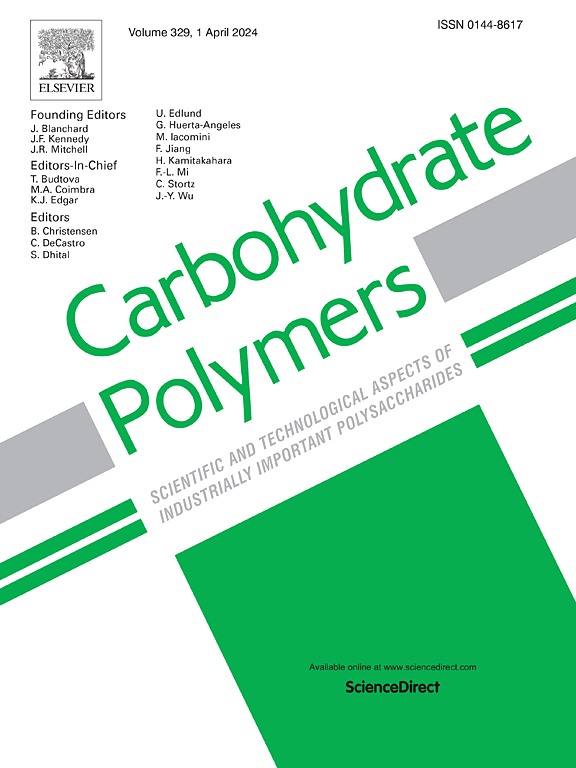Arabinan-rich architectures in pectin Rhamnogalacturonan I domain unveiled by termite digestion: In situ structural insights from solid-state NMR
IF 10.7
1区 化学
Q1 CHEMISTRY, APPLIED
引用次数: 0
Abstract
Pectic polymers, ubiquitous in plant cell walls and widely used in industry, exhibit a wide range of functional properties. However, the sophisticated architecture of their higher-order structures in its native environment, particularly for Rhamnogalacturonan I (RG-I) domain, remains largely elusive. In this study, we innovatively combined solid-state nuclear magnetic resonance (ssNMR) and selective degradation of termites to investigate the molecular architecture of pectin within pine cell wall in situ. Quantitative analysis revealed prominent accumulation of arabinans, particularly those with more α-1,3-branching linkages. Using paramagnetic relaxation enhancement (PRE) ions as molecular probes, we uncovered a correlation between reduced water mobility in the local environment and the increased recalcitrance to degradation of these sugar units. Additionally, molecular dynamics characterization showed that these enriched sugar units experienced minimal changes during digestion. Collectively, our findings reveal a higher-order structural feature within the RG-I region—a compact, arabinan-rich architecture that is resistant to enzymatic degradation. Furthermore, this organization potentially functions as critical structural junctions, akin to the egg-box model, reinforcing the pectic network and maintain cell wall integrity.

白蚁消化揭示了果胶中富含阿拉伯蛋白的鼠李糖半乳糖酸I结构域:固态核磁共振原位结构洞察
果胶聚合物普遍存在于植物细胞壁中,在工业上得到广泛应用,具有广泛的功能特性。然而,它们在天然环境中的高阶结构的复杂结构,特别是鼠李糖乳草酸I (RG-I)结构域,在很大程度上仍然是难以捉摸的。在这项研究中,我们创新地将固态核磁共振(ssNMR)和白蚁的选择性降解相结合,原位研究了松木细胞壁内果胶的分子结构。定量分析显示,阿拉伯品种的积累显著,特别是α-1,3分支键较多的品种。使用顺磁弛豫增强(PRE)离子作为分子探针,我们发现了局部环境中水迁移率降低与这些糖单位降解的抵抗性增加之间的相关性。此外,分子动力学表征表明,这些富集糖单位在消化过程中经历了最小的变化。总的来说,我们的发现揭示了RG-I区域的高阶结构特征-一种紧凑的,富含阿拉伯人的结构,可以抵抗酶降解。此外,这种组织可能起到关键结构连接的作用,类似于蛋盒模型,加强果胶网络并保持细胞壁的完整性。
本文章由计算机程序翻译,如有差异,请以英文原文为准。
求助全文
约1分钟内获得全文
求助全文
来源期刊

Carbohydrate Polymers
化学-高分子科学
CiteScore
22.40
自引率
8.00%
发文量
1286
审稿时长
47 days
期刊介绍:
Carbohydrate Polymers stands as a prominent journal in the glycoscience field, dedicated to exploring and harnessing the potential of polysaccharides with applications spanning bioenergy, bioplastics, biomaterials, biorefining, chemistry, drug delivery, food, health, nanotechnology, packaging, paper, pharmaceuticals, medicine, oil recovery, textiles, tissue engineering, wood, and various aspects of glycoscience.
The journal emphasizes the central role of well-characterized carbohydrate polymers, highlighting their significance as the primary focus rather than a peripheral topic. Each paper must prominently feature at least one named carbohydrate polymer, evident in both citation and title, with a commitment to innovative research that advances scientific knowledge.
 求助内容:
求助内容: 应助结果提醒方式:
应助结果提醒方式:


